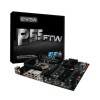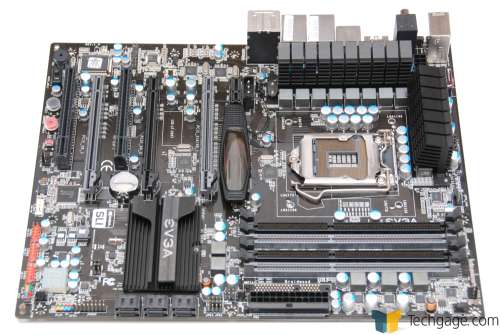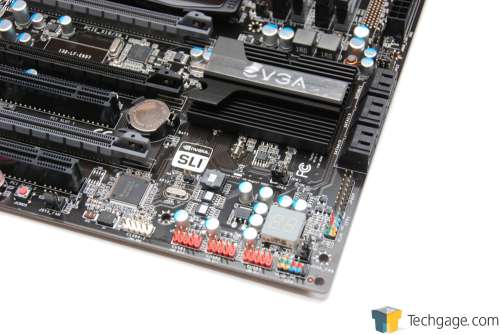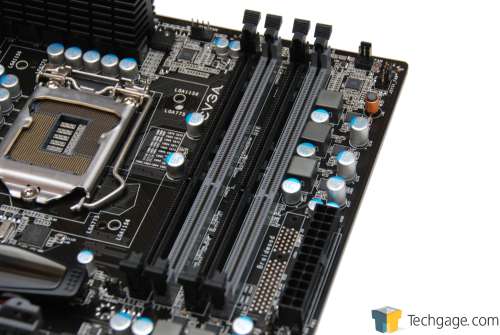- Qualcomm Launches Snapdragon 4 Gen 2 Mobile Platform
- AMD Launches Ryzen PRO 7000 Series Mobile & Desktop Platform
- Intel Launches Sleek Single-Slot Arc Pro A60 Workstation Graphics Card
- NVIDIA Announces Latest Ada Lovelace Additions: GeForce RTX 4060 Ti & RTX 4060
- Maxon Redshift With AMD Radeon GPU Rendering Support Now Available
EVGA P55 FTW

It’s been a while since I last took a look at a motherboard that I knew I wanted in my own machine, but EVGA’s P55 FTW ended that drought. The board lacks S-ATA and USB 3.0, but it has everything else, from great aesthetics and design to impressive overclocking, along with a handful of useful features not often found on the competition’s boards.
Page 1 – Introduction
In our review of Intel’s DP55WG late last month, I mentioned that we’d be working to get a better mixture of motherboard vendors on the site, since we do tend to take a look at many offerings from ASUS and Gigabyte (in our defence, most of these are sent without us knowing first), and to help us keep that promise, we have a board from EVGA we’ve put through its paces.
When I asked EVGA for this particular board, I admit I didn’t know much about it, except that it was popular. So when I received it, and felt a heavy box, I immediately thought, “This board is going to be expensive.” You see, I have been trying to focus more on boards in the $150 – $200 range, because I am increasingly finding that to be the sweet spot lately. Not to mention, there’s only so many people who want to spend upwards of $300 on a board. And yes, I really did jump to conclusions on the price based on the weight of the box alone.
Before I tore the board out of its box, I hit up a popular e-tailer to get an idea on its exact pricing. Sure enough… upwards of $300. Then I began looking over the board, and I could start to understand why it may be worth more than $200, based on its design, and accessories. It wasn’t until long after the testing was completed that I realized I had the pricing all wrong. This board wasn’t $300 at all, but rather $230… much better. It turns out that I originally was looking at the “200” version of the board, which is much more expensive.
It’s not all too often that I’m impressed with a motherboard before even installing it, but this is one of the rarer exceptions. At first glance, the P55 FTW looks like pure quality, and it even “feels” like quality, with everything from the packaging, the board, to the anti-static individual packages for each included accessory.
Closer Look at EVGA’s P55 FTW
If I had to form an overall opinion on a motherboard based on looks alone, I’d have to give the P55 FTW high marks right off the bat. I’m a sucker for dark color schemes, and this board hits all the right marks. It’s pure black, with a little bit of gray mixed in. The only other color found is the blue on the capacitors, and the varying colors on the ATX and USB connectors.
Compared to most motherboards I’ve dealt with in recent months, this one is special in a few ways. First, you’ll notice that there are not one, but two sets of ATX chassis connectors (where you plug your power and reset buttons into), along with a few buttons and an interesting screen in the middle (this is an LED that pulses EVGA’s logo, whether the PC is turned on or not).
Of all that’s interesting here, I’d have to argue that what stands out is the fact that the board includes not one, but two 8-Pin motherboard connectors, along with an option to plug in a Molex connector as well. If overclocking isn’t important to you, these aren’t needed, but it’s clear that EVGA is anxious to cater to a particular crowd.
There’s not too much to be surprised about at the board’s bottom right-hand corner, except for the double ATX chassis connectors. At first, I was stumped as to the reason behind this, but it became obvious quick, and I’ll touch on that in a moment. Also here is a highly-appreciated BIOS readout (BIOS error codes are found in the included manual), along with 3x USB 2.0 internal headers and 1x FireWire.
EVGA offers three different versions of the P55 FTW, and this one (non-“200” and non-“Classified”) is the least-expensive of the bunch, and where that becomes noticeable is with the cutting back on the number of ports, such as S-ATA. While many boards have been offering eight as of late, this one offers six.
At the top right-hand corner of the board we see the 4x DIMM slots as we’d expect, along with a couple of fan connectors. Though somewhat difficult to see, there are a handful of LEDs directly above the DIMM slots which each correspond to a specific component on the motherboard. If a problem arises with any, the LED will light up to let you know.
Support our efforts! With ad revenue at an all-time low for written websites, we're relying more than ever on reader support to help us continue putting so much effort into this type of content. You can support us by becoming a Patron, or by using our Amazon shopping affiliate links listed through our articles. Thanks for your support!








